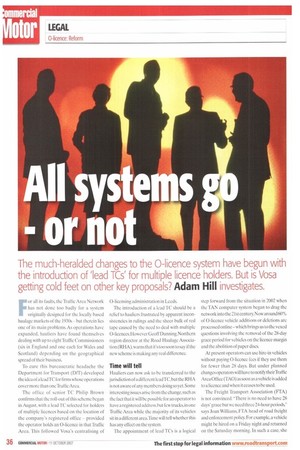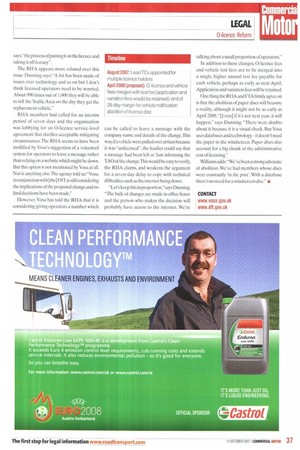The much-heralded changes to the 0-licence system have begun with
Page 36

Page 37

If you've noticed an error in this article please click here to report it so we can fix it.
the introduction of 'lead TCs' for multiple licence holders. But is Vosa getting cold feet on other key proposals? Adam Hill investigates.
For all its faults, the Traffic Area Network has not done too badly for a system originally designed for the locally based haulage markets of the 1930s — but therein lies one of its main problems. As operations have expanded, hauliers have found themselves dealing with up to eight Traffic Commissioners (six in England and one each for Wales and Scotland) depending on the geographical spread of their business.
To cure this bureaucratic headache the Department for Transport (DfT) developed the idea of a leadTC for firms whose operations cover more than one Traffic Area.
The office of senior TC Philip Brown confirms that the roll-out of this scheme began in August, with a lead TC selected for holders of multiple licences based on the location of the company's registered office — provided the operator holds an 0-licence in that Traffic Area. This followed Vosa's centralising of 0-licensing administration in Leeds.
The introduction of a lead TC should be a relief to hauliers frustrated by apparent inconsistencies in rulings and the sheer bulk of red tape caused by the need to deal with multiple 0-licences. However Geoff Dunning,Northern region director at the Road Haulage Association (RHA),warns that it's too soon to say if the new scheme is making any real difference.
Time will tell
Hauliers can now ask to be transferred to the jurisdiction of a different leadTC, but the RHA is not aware of any members doing so yet. Some interesting issues arise from the change,such as the fact that it will be possible for an operator to have a registered address, but few trucks, in one Traffic Area while the majority of its vehicles sit in a different area:lime will tell whether this has any effect on the system.
The appointment of lead TCs is a logical step forward from the situation in 2002 when the TAN computer system began to drag the network into the 21st century. Now around 60% of 0-licence vehicle additions or deletions are processed online —which brings us to the vexed questions involving the removal of the 28-day grace period for vehicles on the licence margin and the abolition of paper discs.
At present operators can use hire-in vehicles without paying 0-licence fees if they use them for fewer than 28 days. But under planned changes operators will have to notifytheirTraffic Area Office (TAO) as soon as a vehicle is added to a licence and when it ceases to he used.
The Freight Transport Association (ETA) is not convinced. "There is no need to have 28 days' grace but we need three 24-hour periods," says Joan Williams, FTA head of road freight and enforcement policy. For example, a vehicle might be hired on a Friday night and returned on the Saturday morning. In such a case, she says,"the process of putting it on the licence and taking it off is crazy".
The RHA appears more relaxed over this issue. Dunning says: "A lot has been made of issues over technology and so on but I don't think licensed operators need to be worried. About 990 times out of 1,000 they will be able to tell the Traffic Area on the day they get the replacement vehicle."
RHA members had called for an interim period of seven days and the organisation was lobbying for an 0-licence service-level agreement that clarifies acceptable mitigating circumstances. The RHA seems to have been mollified by Vosa's suggestion of a voicem ail system for operators to leave a message rather than relying on a website which might be down. But this option is not mentioned by Vosa at all. Nor is anything else.'The agency told us:"Vosa, in conjunction with [the] DfTis still considering the implications of the proposed change and no final decisions have been made."
However, Vlisa has told the RI IA that it is considering giving operators a number which can be called to leave a message with the company name and details of the change. This way, if a vehicle were pulled over at 6am because it was "unlicensed", the haulier could say that a message had been left at 3am informing the TAO of the change:This would be easy to verify: the RHA claims, and weakens the argument for a seven-day delay to cope with technical difficulties such as the in ternet being down.
"Let's keep this in proportion ,"says Dunning. -The bulk of changes are made in office hours and the person who makes the decision will probably have access to the internet. We're talking about a small proportion of operators.
In addition to these changes, 0-licence fees and vehicle test fees are to be merged into a single, higher annual test fee payable for each vehicle, perhaps as early as next April. Application and variation fees will be retained.
One thing the RHA and FIA firmly agree on is that the abolition of paper discs will become a reality, although it might not be as early as April 2008. "[Even] if it's not next year, it will happen," says Dunning. "There were doubts about it because it is a visual check. But Vosa uses databases and technology it doesn't need the paper in the windscreen. Paper discs also account for a big chunk of the administrative cost of licensing."
Williams adds: "We've been a strong advocate of abolition. We've had members whose discs were constantly in the post'. With a database there's no need for a windscreen disc." r
CONTACT www.vosa.gov.uk www.dft.gov.uk


































































































































































































